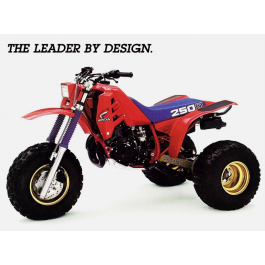Browse By
|
Honda ATC 250RDescriptionHonda ATC 250RHonda Sport ATCs, produced until 1987, were built specifically for performance, and designed for use in racing, or for aggressive trail riding. The machines lacked luggage racks and other utilitarian features, commonplace on most other ATCs or ATVs. In 1970, Honda created the three-wheeled “All Terrain Cycle” market nearly single-handedly with the release of the Honda US90. As the popularity of ATCs exploded in the late seventies, Honda began to diversify their line. Originally catering to winter activity, campers, hunters and weekend Recreational riders that ATCs were envisioned for, their research showed there was a market for utility-focused machines for commercial and agricultural use, and dedicated sport models intended for leisure and competition use. This led to the creation of the ATC250R, a 2-stroke racing ATC based on the CR250 motocross line in 1981 and 3 more Sport ATCs, using 4-stroke engines. The ATC250R remains a popular model for collectors due to its high-performance 2-stroke engines and racing heritage; and the 4-stroke “X” ATCs continue to be popular trail machines. The ATC250R is a high-performance, three-wheeled ATV produced by Honda from 1981 to 1986. Cited as the first high performance ATC introduced, production began with an air-cooled, 248 cc single-cylinder two-stroke engine, but would see a liquid-cooled, 246 cc engine by 1985. All model years were fully suspended and adjustable, using air-assisted front forks and a single, remote reservoir gas-charged rear shock. 1981–1982 models offered 6.7 inches of front suspension travel and 4.3 inches in the rear, 1983–1984 offered 8.7 inches in front and 8.1 inches rear, while post-1985 Models allowed 9.8 inches of travel. All model years also used a gear-driven counter-balancer to reduce engine vibration. Dual disc brakes were used on all model years, with the exception of the 1981, which used a front disc and a rear drum. First generation (1981–1982) The introduction of the 1981 ATC250R marked a milestone in off-road history, as it was the first two-stroke ATC designed specifically for racing. While ATC racing was in its infancy, racers had to rely on Honda's ATC110 and ATC185 models on the racetrack. Both of these four-stroke models were sluggish and poorly suspended when compared to the 2-stroke ATC250R, which borrowed heavily from the Honda CR250R motocross line. Second generation (1983–1984) The 1983 ATC250R incorporated many improvements, introducing the Pro-Link suspension,[2] folding foot pegs, a larger fuel tank, slightly longer travel suspension in front and rear. While the engine design remained similar, the Fuel delivery was increased from the previous 27 mm, to a 30 mm round-slide carburetor. Third generation (1985–1987) Two 1985 Honda ATC 250Rs In 1985 the ATC250R was updated with a 246cc liquid cooled engine, and 6-speed transmission. This 2-stroke engine was notable for not incorporating a power-valve, featured commonly on other machines by 1985. Fuel was delivered via a 34 mm round carb in 1985 and flat slide carburetor for the remainder of production. This would be the last Generation offered for sale, discontinued in the United States in 1986, after an agreement between manufacturers and the Consumer Product Safety Commission to cease production on all 3-wheeled ATVs resulting from thousands of legal battles regarding safety issues and high accident rates. US Dealers were instructed to remove the motors and other common parts of remaining models, and then cut the frames in half to prevent new sales. The 1987 ATC250R models were released in limited numbers in Europe and Canada.[3] While rumors persist that the 1987 Models were intended to feature new colors, a redesigned logo, and possibly keyed ignition, these models were virtually identical to the ‘86 offering. Though sold concurrently, the Honda TRX250R would remain in the Honda line-up until 1989, effectively becoming the ATC's successor. The four-wheeler used many of the same components as the ATC250R, including a slightly detuned version of the ATC's engine. Here is a YouTube video of an original ad for the ATC 250R Detailed Information
Additional InformationAdditional Information
|








